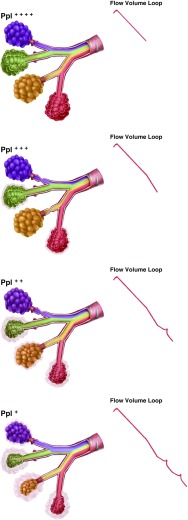Figure 4.
Schema showing choke points in airway segments in parallel and how these can potentially result in peaks on the expiratory limb of the flow–volume curve. Each segment is colored differently to show representative contribution from that airway segment to total airflow. The relative intrabronchial area occupied by a color represents the contribution to airflow from that airway segment. At the beginning of a forced exhalation maneuver, all segmental airways are open, and the colors are equally distributed. Initially, the intraalveolar pressures are very positive, and with exhalation this pressure gets progressively dissipated in the airways. With forced exhalation, the intrapleural pressure (Ppl) is initially high, and when the intrapleural pressure equals and exceeds the intrabronchial pressure in an airway branch, that airway collapses and there is a resultant decrease in the rate of decline of airflow. With progressive decrease in intrapleural pressure with exhalation, previously collapsed airway segments open up as their intrabronchial pressure rises above the intrapleural pressure.

